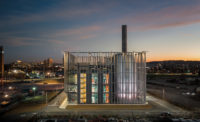Hamburg
Hegger Hegger Schleiff Architekten
In Hamburg, a former Nazi bunker has reopened with an unlikely new program as a sustainable-energy facility. Built in 1943 as a combined air raid shelter and anti-aircraft artillery tower, the 90,570-square-foot concrete-and-steel structure is fortified with 6-foot-thick walls and a 12-foot-thick roof. In 1947, the British attempted to raze it during postwar disarmament, demolishing six of the eight floors inside before abandoning the project. The building sat vacant for more than 60 years. In 2008, fearing the bunker was at the brink of collapse, the city turned to Kassel, Germany–based Hegger Hegger Schleiff Architekten to convert it into a renewable-energy plant. Following a two-year, $37 million renovation, the resulting power plant-cum-exhibition hall-cum café serves thousands of local residents through a massive heat-storage unit fed by solar thermal panels, waste heat from an industrial plant, wood combustion, and biomethane gas. The architects restored the facade to its original state, with a couple of notable additions: solar panels along the roof and south face, and a large window, which the team glazed after using the opening to remove 25,000 tons of concrete rubble. Though the architects gutted most of the interior, they left the concrete walls intact—including graffiti and drawings left by civilians during wartime—as an acknowledgement of the building's complicated past.














Post a comment to this article
Report Abusive Comment